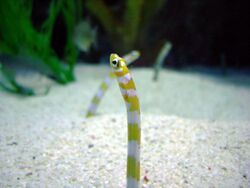Biology:Gorgasia preclara
| Gorgasia preclara | |
|---|---|

| |
| Scientific classification | |
| Domain: | Eukaryota |
| Kingdom: | Animalia |
| Phylum: | Chordata |
| Class: | Actinopterygii |
| Order: | Anguilliformes |
| Family: | Congridae |
| Genus: | Gorgasia |
| Species: | G. preclara
|
| Binomial name | |
| Gorgasia preclara J. E. Böhlke & J. E. Randall, 1981
| |
File:Splendid garden eel - 2014 11 08.ogv
Gorgasia preclara, the splendid garden eel or orange-barred garden eel, is a species of marine garden eel.
Description
The splendid garden eel is a medium-sized fish, up to 40 cm maximum length.[2] Its body has a circular shape with a diameter of about 10 mm.[3] Its body color is yellow to orange with characteristic white bands.
Distribution and habitat
Gorgasia preclara is widespread throughout the tropical waters of the Indo-West Pacific area from the Maldives to Indonesian archipelago and the Papua New Guinea and north to Ryukyu, Japanese archipelagos, and south to the Philippines .[4] It occurs in sandy areas exposed to currents at depths between 18 and 75 m, but is usually observed at an average depth of 30 m.[5]
Biology
The splendid garden eel lives in a buried tube in the sand either alone or in groups ranging anywhere from three to over a thousand eels.[6] Typically, only its head and uppermost body protrudes from the sand, and it will retreat entirely if approached by large fish or divers. They feed on drifting plankton.[7]
Reproduction
During mating season male and female eels will move burrows to increase proximity to one another. Males will often engage in a courtship display of protective behaviors and may bite rival eels. After a male has won a display, the male and female eel will stretch from their burrows to intertwine bodies. [8] Splendid garden eels are pelagic spawners, meaning that female eels will release fertilized eggs into the current. When the eggs hatch in the current, larvae continue to float until they reach a certain size. Once they've hit this size threshold juvenile eels will dig their sand burrow. [8]
References
- ↑ Tighe, K.; Smith, D.G.; McCosker, J. (2019). "Gorgasia preclara". IUCN Red List of Threatened Species 2019: e.T199411A2592594. doi:10.2305/IUCN.UK.2019-1.RLTS.T199411A2592594.en. https://www.iucnredlist.org/species/199411/2592594. Retrieved 6 January 2022.
- ↑ Burgess, W.E., H.R. Axelrod and R.E. Hunziker III, 1990. Dr. Burgess's Atlas der Meerwasser Aquarium Fische. Bede Verlag, Kollnburg, Germany.
- ↑ Kuiter, R.H. and T. Tonozuka, 2001. Pictorial guide to Indonesian reef fishes. Part 1. Eels- Snappers, Muraenidae - Lutjanidae. Zoonetics, Australia. 302 p.
- ↑ Castle, P.H.J. and J.E. Randall 1999 Revision of Indo-Pacific garden eels (Congridae: Heterocongrinae), with descriptions of five new species. Indo-Pac. Fish. (30):52 p.
- ↑ Lieske, E. and R. Myers, 1994. Collins Pocket Guide. Coral reef fishes. Indo-Pacific & Caribbean including the Red Sea. Harper Collins Publishers, 400 p.
- ↑ Kuiter, R.H. and T. Tonozuka, 2001. Pictorial guide to Indonesian reef fishes. Part 1. Eels- Snappers, Muraenidae - Lutjanidae. Zoonetics, Australia. 302 p.
- ↑ Myers, R.F., 1999. Micronesian reef fishes: a comprehensive guide to the coral reef fishes of Micronesia, 3rd revised and expanded edition. Coral Graphics, Barrigada, Guam. 330 p.
- ↑ 8.0 8.1 "Splendid garden eel animal guide". Georgia Aquarium. https://www.georgiaaquarium.org/animal/splendid-garden-eel/.
External links
- Photos of Gorgasia preclara on Sealife Collection
Wikidata ☰ Q2564483 entry
 |


